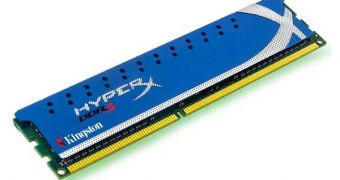After how closely we monitored the dramatic decline in the DRAM market, and all the problems it caused, you'd think all companies involved would have had a rough time, but that doesn't appear to be true for Kingston.
According to a recent report from Digitimes, Kingston actually did well for itself on the DRAM market over the course of 2011.
More precisely, its shipments of dynamic random access memory products went up instead of down, and by quite a bit too, namely 20%, in Asia Pacific anyway.
This let it make up for the fall in chip prices and allowed the company to keep a hold of its dominant market share on the worldwide market (50%).
The HyperX series of PC memory was one of the causes behind the positive sales evolution.
The larger part of the credit goes to the data center and server market though, since those yield higher margins.
In fact, Kingston will focus on these areas this year (2012), since conventional PCs aren't being bought as readily as before.
All in all, Kingston got the better end of the deal last year, unlike Elpida, whose fate has taken a turn for the worse.
Speaking of which, the company has already filed for bankruptcy, having been denied government protection.
This is all in spite of real advancements like the world's smallest (at one time anyway) 25nm 4Gb DDR3 chip, 1600Mbps low-power DDR3 mobile RAM, 3D-TSV stacked DDR3 chips and various other 25nm products.
On a related note, DRAM chip prices have begun to stabilize, though there is still room for further ASP drop and supplier headaches.
At this point, we can't see any chance for a rapid rebound, not that customers are ever going to be upset about low prices.
That said, 3D RAM chips could be just what the industry needs to breathe some life back into this market segment. Alas, it will take years for them to be standardized.

 14 DAY TRIAL //
14 DAY TRIAL //